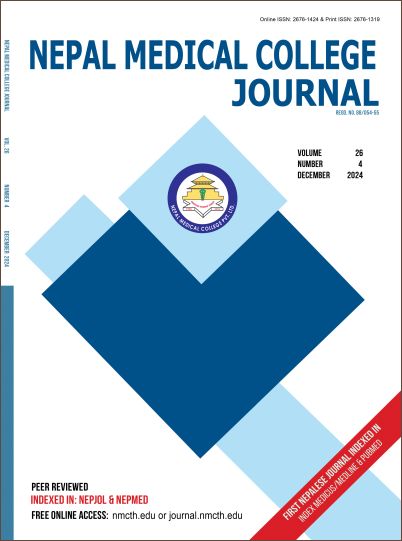Relationship of Dermatoglyphics Pattern and Malocclusion among Individual Visiting a Tertiary Dental Care Center in Kathmandu
DOI:
https://doi.org/10.3126/nmcj.v26i4.74453Keywords:
Dermatoglyphics, finger pattern, malocclusion, occlusionAbstract
Dermatoglyphics is used as diagnostic and research tool in many fields including forensics to identify the individuals by forensic experts and in association with various medical conditions. The development of teeth and its associated structures coincide with the development of epidermal ridges during the 6th to 13th week of intrauterine life. This forms the basis for studying the association of dental anomalies with fingerprint pattern, malocclusion being most commonly reported oral conditions and is widely prevalent. Individuals including students and interns within the age group of 18-24 years visiting Nepal Medical College and Teaching Hospital, Attarkhel, Gokarneshwor-8, Kathmandu from April 2024 - June 2024 were included after signing the written consent form. Malocclusion was assessed based on Angle’s classification according to which participants were grouped into Class I, Class II, and Class III malocclusion. The fingerprints of all ten fingers of both the hands of the participants were recorded with ink by using roller method as suggested by Cummins and Midlo. Descriptive statistics was presented in the form of frequency, percentage, mean and standard deviation. Chi square test was done to find out the association of dermatoglyphic pattern with malocclusion using SPSS- 17 software with significance level set at P <0.05. Most of the study participants (120, 71.4%) had Angle’s Class I malocclusion followed by Class II (26, 15.5%) and Class III (22, 13.1%). The most common dermatoglyphic pattern among all the fingers was the loop pattern seen in little finger of left hand of study participants with Class I malocclusion (88, 73.3%) and little finger of right hand among those with Class II malocclusion (22, 84.6%) and Class III malocclusion (17, 77.3%). There was no statistically significant association between dermatoglyphic patterns and type of malocclusion (p-value 0.156 for loop pattern, p-value 0.915 for whorl pattern and p-value 0.126 for arch pattern) dermatoglyphic investigation being convenient, cost effective and non invasive, had been applied in many fields including dentistry. It has been used as a diagnostic tool to unveil genetic factors related to many oral diseases, however, it cannot be relied upon as a sole factor.
Downloads
Downloads
Published
How to Cite
Issue
Section
License
Copyright (c) 2024 Nepal Medical College Journal

This work is licensed under a Creative Commons Attribution 4.0 International License.
This license enables reusers to distribute, remix, adapt, and build upon the material in any medium or format, so long as attribution is given to the creator. The license allows for commercial use.




